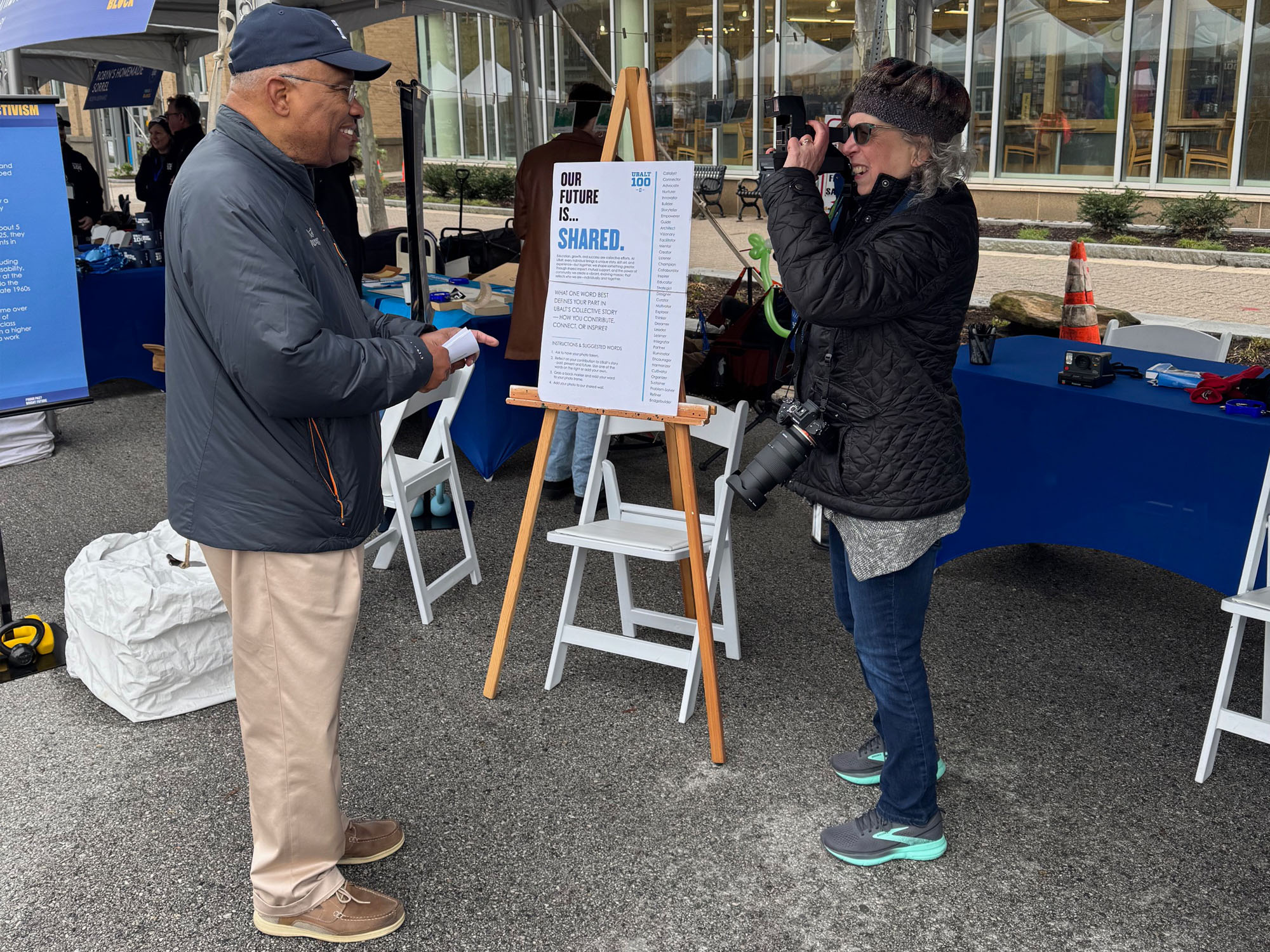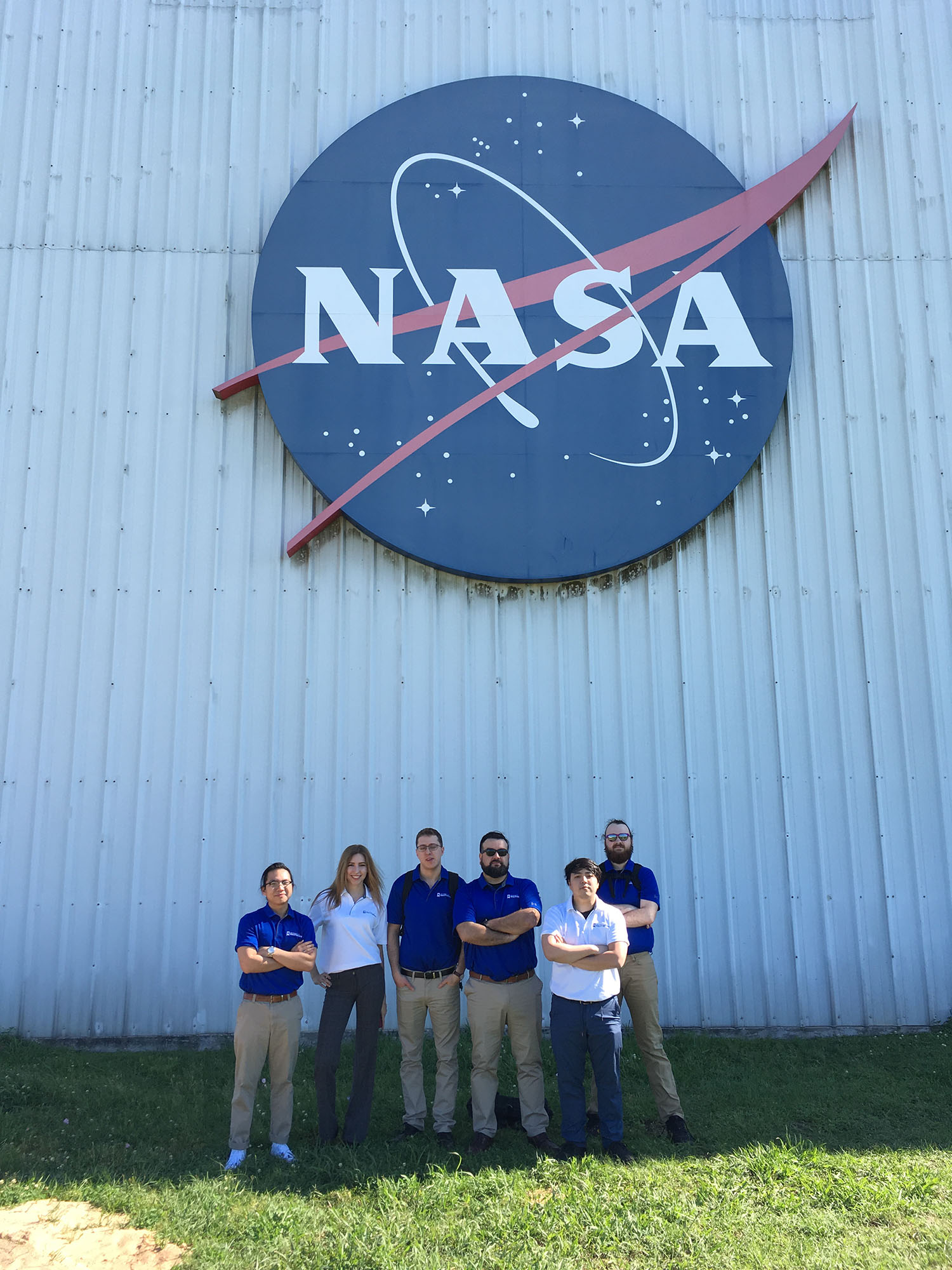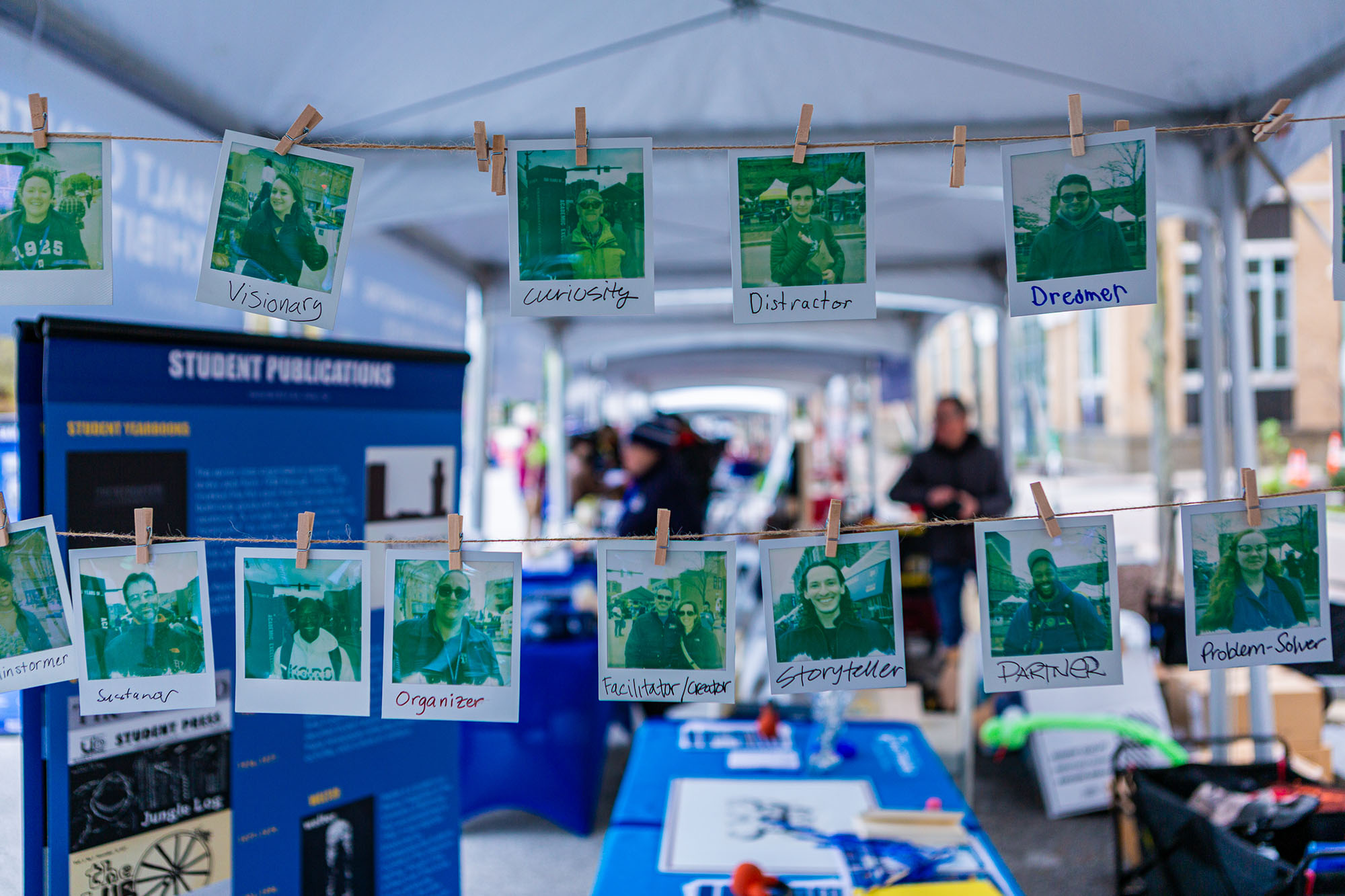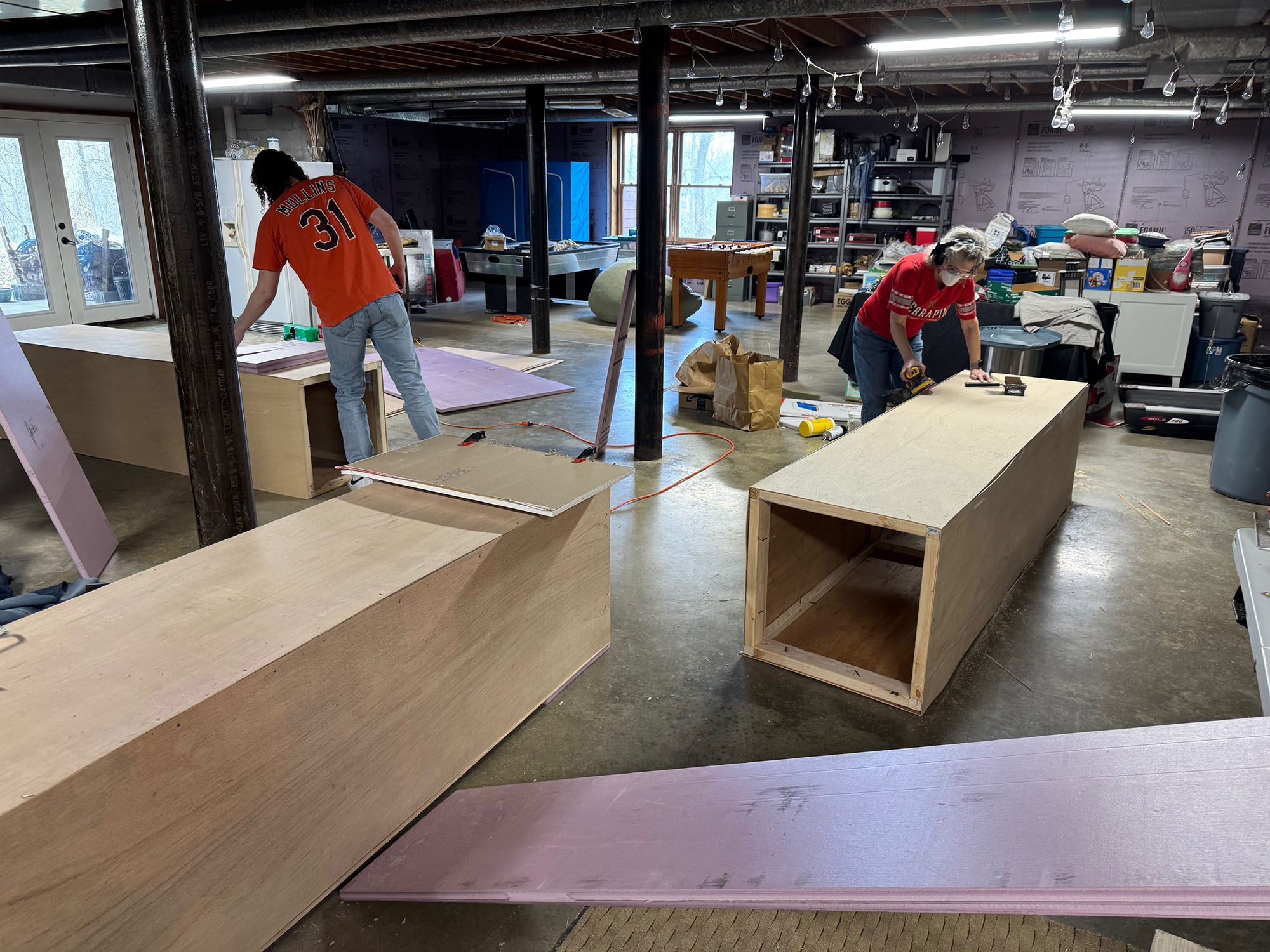
Guests of The University of Baltimore’s Centennial Grand Celebration on Thursday, Nov. 13 will get to experience 100 years of innovation, community and transformation through a series of faculty-imagined exhibits.
For the past 18 months, three professors from Yale Gordon College of Arts and Sciences—Megan Rhee, Julie Simon and Giovanni Vincenti—have been thinking about how to visualize UBalt’s proud past and bright future. They’ve invited students in, too, to be part of this momentous effort.
The result is eight exhibits that tell the University’s story over time and imagine what’s to come. Like a museum, some will even invite guests in through interactive and engaging activities.
For a deeper look at each exhibit, all are welcome to join the UBalt community at its Nov. 13 event. Tickets are still on sale. Until then, we asked each of the professors to share about what their involvement in this once-in-a-century project meant to them.
Q: Tell us a bit about your vision and the exhibits you made for our Centennial Grand Celebration.
Megan Rhee, MFA ‘08, assistant professor and program director for the MFA in Integrated Design: When we were approached about taking this on, I knew it would be a challenge to get anyone to predict a future in such a rapidly changing moment in history. And it was!
What makes us proud about our past is exactly what makes us excited about our future. This is an amazing place and so we came to think of the exhibit and our work as being inspired by a series of words that embody UBalt currently, and we believe will continue to make our future bright: Limitless, Transformative, Engaged, to name a few. The vision really was that each word and exhibit was inspired by what we’ve always done and what we hope we will always do!
Julie Simon, professor: My vision for the exhibits I built was interaction. The more you can touch, the more you understand the concept. I built a loom and a UBalt sign. With the loom, picking the color of fabric you want to weave into the tapestry forces thinking about how you fit into the goals of the piece: What is your role?
Giovanni Vincenti, associate professor and program director for the B.S. in Applied
Information Technology and B.S. in Artificial Intelligence for IT Operations programs:

Starting in 2018, students participated NASA S.U.I.T.S. (Spacesuit User Interface Technologies for Students). This open challenge asked students to create augmented reality (AR) displays that may be incorporated into future-generation spacesuits, which will be instrumental for humanity to return to the Moon and then on to Mars.
The original team, the Poegrammers, was selected to go to Johnson Space Center in Houston, Texas and demonstrate their solution. Two more teams followed. The system that initiated with the Poegrammers, ARGOS (Augmented Reality Guidance and Operations System), has evolved significantly for each iteration.
Our exhibit gives participants a taste of what our students learned. The AR headset features the lunar landscape that astronauts of Apollo 12 experienced, along with newer technologies that will support future missions. Participants will also experience a simulation of consumables (oxygen, water, and battery power), displayed in an overlay inspired by our students’ work.
Q: Which aspect of your exhibits, or which exhibit, are you most excited to share during the Celebration?
Rhee: I think there’s something I love about each one of them since they’re all so different. I love our pillars—our future is collaborative. It’s been great talking with students, staff, alumni and UBalt neighbors about what makes UBalt unique and what inspires them about this place. Every time we bring the pillars out and people start writing on them, I get excited to see their engagement and the unique perspectives they share. I love that you can look at one and see something different on every side.
But Our Future is Limitless is probably the one I’m most looking forward to sharing. I wanted to represent some of UBalt’s data in a more artistic way—and we have some incredible statistics! Ultimately, I focused on visualizing our living alumni. As I assembled the piece, I kept thinking about how many people—still living, and those who’ve passed—have been touched by UBalt. Each
time I placed one of the representative balls, I thought about the difference each alum has made and the collective influence of our community over the past 100 years. It’s easy for me to feel connected to this one—not only because I’m faculty here, but because I’m also a proud alum whose own life was shaped by UBalt, and who now has the privilege of helping shape the experiences of future alumni.
Simon: I’m excited to see how the attendees interact with all the exhibits. They all focus on the past, present and future of the University. It’s a story that we hope to present in pieces all night.
Vincenti: As most people have not experienced immersive augmented reality technologies, I am looking forward to showing off the possibilities that this technology affords. Imagining yourself working on the Moon is quite different from seeing it through such immersive simulation, which then really makes one appreciate the potential that technology has to offer in such desolated environment.

Q: How does it feel to play this important part of the Centennial celebration?
Rhee: I’m a traditional communication designer, so building large exhibit pieces definitely isn’t part of my day-to-day work! That’s made this experience especially fun and freeing—getting to build, create, and collaborate with people across campus to bring these pieces to life.
And anytime you can bring a student into the process, it’s just the best. Jake Hicks was patient, thoughtful and strategic throughout the exhibit design. It’s been a true privilege to be part of it all.

Simon: 100 years is a long time. The University has changed significantly since its business night school mission. When I started at UBalt in 1989, it was a completely different place. We were an upper division and graduate school with a small faculty and limited facilities. I’ve seen it grow and contract.
Vincenti: The Poegrammers and later the AstroBees, along with the faculty advisers, created a project that was not only exceptional in terms of our motto, “Knowledge That Works,” but also valuable to advanced research teams at NASA. We were able to break the sometimes-tedious routine of teaching concepts by breaking into what is literally the next frontier of humanity.
Personally, the experience that I had with the students through those years was the pinnacle of my teaching career (so far).
Q: What do you hope people takeaway with them from engaging with your exhibits? What will you take away from this experience?

Rhee: I hope they walk away with memories, connection points and a renewed sense of how special UBalt really is. I want them to dream a little—about how our past leads us into the future, and how that future, while always evolving, will be bright. And that we each have a role in shaping what comes next.
For me, I’ll take away a deep sense of pride—not just in the finished works, but in the collaborations, conversations and community that made them possible.
Simon: I feel depending on your relationship with the University you’ll take away different things. Former students are going to see what we’ve done one way. Current faculty will view it differently.
It’s been a pleasure working with Megan and Jake on a collaborative project. In my own artwork I tend to work alone; I’ve enjoyed the teamwork and collaboration.
Vincenti: UBalt and the experience that students may have has the potential of going well beyond the walls of our institution. The ability of our faculty to guide diligent and achieving students, coupled with the support that the University is willing to give, has the potential for exceptionality. We did not have any experience in the domain on space exploration, but we learned, we practiced, and we earned a seat for several years at a very unique table. This exhibit is about how uncomfortable and out of place our students were, yet they managed to perform and deliver what at first seemed impossible.
RELATED CONTENT
WATCH: Megan Rhee shares about her UBalt experience as an alum and professor with one of her MFA students in a Centennial Pillar video
READ: Julie Simon discusses her time as a professor and her professional photography skills
WATCH: UBalt’s NASA S.U.I.T.S. teams - Poegrammers and AstroBees - discuss their AR project and participation in the unique competition
DIVE INTO HISTORY: Visit our Centennial website to see UBalt's 100-year timeline, learn about our past presidents, hear stories from our community members, learn about our Nov. 13 celebration and more.

